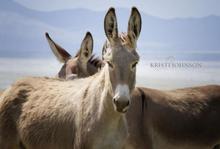The American Wild Horse Preservation Campaign is pleased to announce that it is now managing The Platero Project, a program dedicated to promoting awareness about Americaâs wild burros and keeping them wild and free on the range.

Saving America's wild burros
The Platero Project is funded by an anonymous donor who developed a deep appreciation for burros after reading their story as a child and who is very passionate about and dedicated to saving Americaâs remaining burro herds.
© 2015 by Kristi Johnson
The Platero Project is named for small donkey and main character of the poetic short story, and literary classic: âPlatero y Yoâ (Platero and I) written by Spanish Nobel Laureate: Juan Ramon Jimenez. Platero symbolized tenderness and purity and a reflection on the simple joys of life.
The project is funded by an anonymous donor who developed a deep appreciation for burros after reading the story as a child, who feels that burros are underrepresented in the reporting of the plight of burros and mustangs on the range, and who is very passionate about and dedicated to saving Americaâs remaining burro herds.
âWild burros have the same rich history and are as culturally significant as wild horses, but they receive far less attention,â said AWHPC director Suzanne Roy. âThe Platero Project aims to change that by elevating their status and promoting awareness and appreciation for these amazing and unique residents of the American Southwest.â
âAmericaâs burros are protected under federal law, but they are in crisis due to government mismanagement which has caused dwindling numbers, lack of genetic diversity and inbreeding,â said Deniz Bolbol, AWHPC Director of Field Operations who will be leading the new burro project. âOur goal is to keep wild burros wild and free on the range through humane management programs and initiatives to ensure healthy populations of wild burros living on our public lands.â
Nationally, fewer than 11,000 burros are estimated to remain on U.S. Bureau of Land Management (BLM) and Forest Service lands in five western states. These agencies have historically managed burros by rounding them up with helicopters and removing large numbers of them from the range.
Most of the remaining burro populations are too small to remain genetically viable. In June 2013, the National Academy of Sciences conducted a review of the BLM Wild Horse and Burro Program and noted, âThe burro population is more fragmented than the horse population,â and warned that ââremoving burros permanently from the range could jeopardize the genetic health of the total population.â
Background on US Burros
Burros are a member of the horse family, Equidae. Originally from Africa, they were introduced to the Desert Southwest by the Spaniards in the 1500âs. (The word âburroâ is derived from the Spanish word âborrico,â meaning donkey.) Today, most of Americaâs wild burros reside in Arizona, where they have been present since 1679, when Jesuit priest Padre Eusebion Kino brought them to the Spanish mission at San Xavier del Bac near what is now Tucson.
Burros accompanied explorers and pioneers on their treks throughout the West, surviving even when the harsh conditions claimed the lives of their human âowners.â By the Gold Rush years of the 19th century, burros were used primarily in the Southwest as pack animals for prospectors. They worked tirelessly to carry supplies, ore, water and machinery to mining camps, and became indispensable to the workers. At the end of the mining boom many of them escaped or were turned loose, and with their innate ability to survive under the harshest conditions, wild herds eventually formed and flourished.
Wild burros are equally protected under the unanimously passed Wild Free Roaming Horses and Burros Act of 1971 as âliving symbols of the historic and pioneer spirit of the Westâ that âenrich the lives of the American people.â
The American Wild Horse Preservation Campaign (AWHPC) is dedicated to preserving American wild horses and burros in viable, free-roaming herds for generations to come, as part of our national heritage. AWHPCâs mission is endorsed by a coalition of more than 60 horse and burro advocacy, public interest, and conservation organizations.
